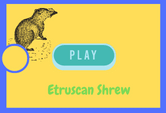Etruscan Shrew Game Quiz Online
This page features a Etruscan Shrew Game Quiz Online. It is an exercise for students studying science in 3rd, 4th, 5th, 6th to 8th grades. Students will learn about etruscan shrew in this online activity. Play this game and learn about both. Remember to learn more by readding the article below.

Etruscan Shrew Coloring Pages For Kids
You may want to draw an Etruscan shrew for kids. There are free printable coloring pages that you can download and print. You can also draw it yourself to learn more about this fascinating creature. You'll discover some interesting facts about shrews in this article. You'll learn more about its size, habitat, and sensory world.
Size
The Etruscan shrew is one of the smallest mammals on earth. Its small size means that its muscle is very small, which has some consequences. However, researchers have studied this shrew's neuroanatomy to discover the benefits and costs of its tiny size. They have found that its size allows it to live in areas with low productivity and low-level encounter rates. Despite its small size, it has a large range of habitats and a high energy retention.
The brain of the Etruscan shrew is one of the smallest among mammal species. Its cerebral cortex is 400-500 um across and is cytoarchitectonically heterogeneous, with similar cortical boundaries. Its myelin and cytochrome oxidase staining reveals the presence of multiple sensory neocortical areas, including the olfactory bulb.
Habitat
The Habitat of the Etruscan Shrew is a variety of grassy fields and lowland forests. This species is predominantly found in the Mediterranean basin, but is also found in Central Asia and the Arabian Peninsula. It is likely solitary and territorial, and avoids moving across open fields, seeking refuge under a dense layer of organic material. Old dry stone walls are common habitats for this species, as they often serve as resting and breeding sites.
The brain of the Etruscan shrew is very small, but its behavioral capacity is remarkable for a creature of this size and shape. Unlike other related species of shrews, which have very few sensory cortical areas, Etruscan shrews have two primary visual and auditory cortexes and a single somatosensory cortex. Their neurophysiology is consistent with other insectivores.
Sensory world
In addition to the human brain, the Etruscan shrew has a highly organized sensory periphery, and its trigeminal nerve is the largest of all sense organs. The brain of this small insectivore is not particularly large, but it does have extensive representation of the nose and whiskers. The brain of this animal also possesses a push-pull framework, constraining the total size of its CNS.
The Etruscan shrew responds to a variety of auditory stimuli, with the most efficient stimulus being a key ringing. Moreover, high-frequency hearing is predominant in this species, as indicated by strong selectivity for metallic clanging. To map the sensory field of this shrew, the contralateral body surface was mapped by making light, rapid strokes with a thin metal stick. Then, the number and extent of each whisker's receptive field were calculated. The ipsilateral body surface was also mapped, although most receptive fields were bilateral.
Brain size
The seasonal differences in brain size of some shrew species may be the most dramatic reversible transformations of mammalian central nervous systems to date. Brain mass decreases by up to 20% from summer to winter and re-grows between nine and sixteen percent in the spring. While the exact reason for these variations is not yet known, researchers have determined that differences between sexes and seasons are consistent with a decrease in the size of various brain structures.
The Etruscan shrew has the smallest brain of any mammal, with an average cerebral cortex of 400-500 um. This brain is a heterogeneous sheet of tissue, with identical cortical borders, and several sensory cortical areas. Among the cortical areas, the S1 area, the secondary somatosensory cortex, and the visual cortex have been identified. Electrophysiological recordings from Etruscan shrews have demonstrated that the brain is divided into several areas.
Body temperature
The Etruscan shrew has a distinctive snout that is distinguished by its prominent whisker fan. It has large macro vibrissae used to target prey and smaller micro vibrissae for initiating the final strike. In addition, the shrew has an array of six rows of whiskers in its snout, arranged in several arcs. Its size and body mass make it a great candidate for the smallest mammal. It has a mass of 2.4 grams, which makes it one of the lightest mammals in the world. Its small size makes it difficult to conserve body heat. Its body heat is lost quickly, but its metabolism runs at a similar temperature to a human. This is likely due to its mitochondria, which burn hot all the time. It also breathes extremely rapidly: up to 800 times per minute, compared to 12 to 20 times a minute for humans.
Venom
A recent study has found that the venom of the Etruscan shrew has cardiotoxic and paralytic effects. The researchers conducted physiological bioassays using frog and mealworm beetles as well as a common shrew's saliva. The results showed a significant difference immediately after the venom was administered, as well as one minute after the shrew's saliva was administered.
The shrew carries enough venom in its venom gland to kill two hundred mice, which is equivalent to the venom of the tiger snake. The shrew uses this venom in live hoarding. Shrews do not have hollow fangs, instead, they have a gland that releases venom in their saliva. When they bite their prey, they insert their venom-filled saliva into their wound. This paralyzes the prey.
